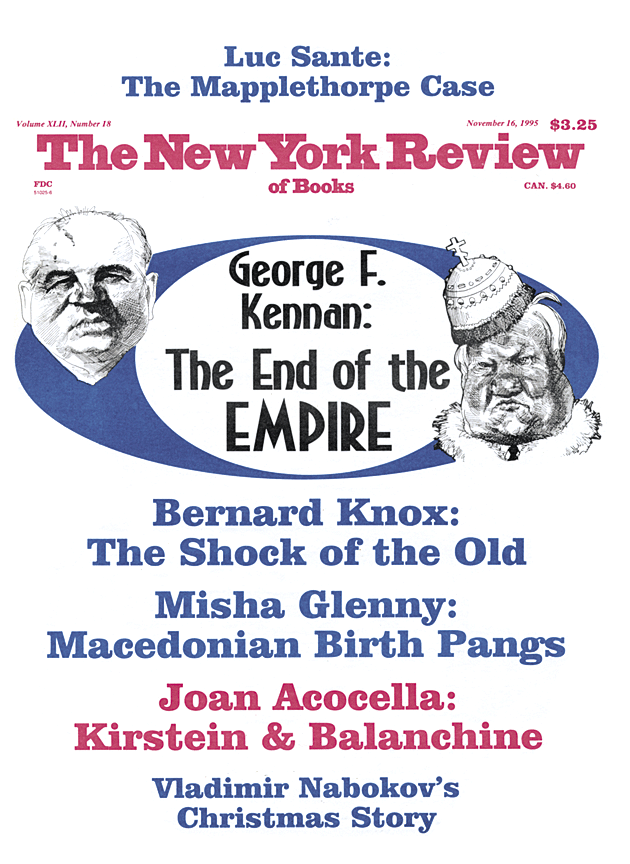In response to:
Beethoven's Triumph from the September 21, 1995 issue
To the Editors:
In Charles Rosen’s review of William Kinderman’s highly stimulating book on Beethoven [NYR, September 21], he raises a question about a quotation from one of my articles. The context from which this quote is taken is readily available in my book Music Sounded Out (“Beethoven’s New Style,” page 71). To sum it up: During the inversion of the fugue of opus 110, the constraints of polyphony are shaken off in a gradual process of foreshortening that is a feature of the movement’s return to life. (Incidentally, Rosen seems to misread the meaning of “poi a poi di nuovo vivente.” Since it follows the indication “l’istesso tempo della Fuga” it does not, as I understand it, denote increasing speed but increasing vivacity and intensity.) At the same time, the appearance of the augmented theme in its original, upward shape initiates a process of liquidation: when the basic key of A flat is reached, the texture has become virtually homophonic. The goal of revival has been attained. But Beethoven proceeds even further. The lyrical hymn in A flat that carries the piece to its end becomes more and more euphoric until another, ultimate liberation is achieved: finally, after an exertion that surmounts two fortissimo diminished seventh chords, the “chains of music itself” are thrown off. This last extreme effort amounts to a kind of musical self-immolation; it needs to be conveyed by the performance before silence takes over. In my view, only an extreme metaphor could do it justice.
Alfred Brendel
London, England
Charles Rosen replies:
I made no criticism of Alfred Brendel in my review. I only wrote that I assumed he meant something specific by the grandiose expression “the chains of music itself”; I was reproaching William Kinderman (who occasionally writes program-notes for Brendel) with quoting from the work of other scholars out of context in a way that makes their phrases seem empty and pretentious. There was, therefore, no reason to refer to Brendel’s book, although I am glad that it is readily available, since I was sure that the particular metaphor had some justification. I agree that the lyric euphoria of the final page of opus 110 is extraordinary. In his letter, however, Brendel has now added the additional metaphor of “musical self-immolation” which is less persuasive. It is not so much its lack of clarity that is unfortunate (who is being immolated, Beethoven, the pianist, or the sonata itself?) but the Wagnerian resonance which can be applied to Beethoven only with a certain lack of tact. Beethoven’s pretensions may be as great as Wagner’s, but they are less morbid and less coarse.
It would be impertinent to claim that Brendel’s interpretation of “poi a poi di nuovo vivente” (little by little with new life) is a “misreading.” It is, of course, a possible reading, but it is in my view less coherent than the one I offered, and it takes less account of the sonata as a whole. It is also less probable, since playing with “increasing vivacity and intensity” would normally imply at least a slight rise in the dynamic level, and at this place Beethoven explicitly directs the soft pedal for a full twenty-eight bars and no dynamic indication whatever until the crescendo after twenty-four bars. The most viable reading of “The same tempo as the fugue, little by little with new life” would be as a direction to the performer to begin in the tempo of the fugue, and then, as the music proceeds, to play with a very gradual increase of animation. In this way, as elsewhere throughout this wonderful movement, each tempo would be seamlessly transformed into the next, and the whole work conceived and performed in one unbroken flow.
As far as I can see, Kinderman and I are not far apart, and his observations about Beethoven’s telescoping of the fugue theme in the Meno Allegro are brilliantly perceptive; his sensitivity to motivic structure is, as always, impressive. If this telescoping of the theme already played three times as fast is what he means by “double diminution,” then the description is indeed apt. I thought we disagreed about the actual velocity: writing notes that are twice as fast while directing the performer to play more slowly (Meno Allegro) should not be construed as an awkward and unprepared change of tempo. I interpret the Meno Allegro as a change in notation which allows Beethoven to accelerate from the theme played very slowly back into the original tempo and end up with the original notation. The feeling of new life should be gradual and imperceptible. I find a sudden change of tempo not musically unacceptable here, but textually unjustifiable as well, given Beethoven’s insistence throughout this page that all the effects be accomplished little by little (“poi a poi“).
It is clear from the autograph that Beethoven had difficulty in notating the rhythm of this passage: in the bars following Meno Allegro, he writes a sixteenth-note rest mistakenly for an eighth-note rest three times, although he managed to correct one of these errors in the manuscript. The difficulty is understandable since the rhythmic conception of transforming a theme at half-tempo gradually into the original tempo with a dramatic effect of new life and vigor was unprecedented in the history of music. The extraordinary telescoping of the theme signaled by Kinderman is more telling when heard as part of an ongoing and continuous process.
This Issue
November 16, 1995


